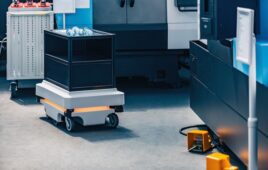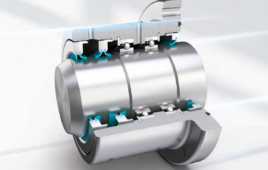Researchers at MIT Media Lab, the University of Pisa, and Université Libre de Bruxelles have been experimenting with using swarm robotic systems for autonomous waste management. Outlined in their paper, the approach applies bio-inspired foraging methods to swarm robotics with the purpose of improving waste management in cities.
“With autonomous vehicles, swarms of drones for deliveries and teams of robots organizing warehouses, the city of the future will be a cybernetic ecosystem consisting of machines and humans,” said Antonio Luca Alfeo, a researcher who carried out the study, according to Tech Xplore. “This is a fascinating scenario, as well as a huge technological challenge. The management of such systems results in a complexity that grows exponentially as more machines are deployed, especially if we want them to actually ‘live with us’ and react autonomously to the changing needs of their surrounding environment.”
In their studies, the researchers applied nature-inspired solutions to the management of robot swarms.
“We propose a trash disposal system with swarms of robots whose self-organization is based on the behavior of social insects, also known as stigmergy-based foraging,” said Alfeo. “The proposed system deals with the disposal of trash, from trash bins to a few central deposits.”
None of the robots that were developed in this project are controlled or given directions by remote service. In fact, all of their decisions are made in real-time at that exact moment. These decisions are based on the robots’ perceptions and real-time observations.
“Among these perceptions, there are also ‘virtual pheromones’ released by other robots on RFID tags in the urban environment,” said Alfeo. “These mark the most convenient path from one or more non-empty trash bins and the nearest deposit. Most importantly, thanks to its collective behavior, the swarm is able to autonomously self-organize in order to target the areas with the greatest amount of garbage, always providing an effective response.”
Individuals with backgrounds in city science, bio-inspired robotics, and data science helped developed this autonomous solution.
“Team members specialized in city science provided the model of the robot used in the study and dealt with the modeling of urban space in GAMA, a multi-agent simulation platform,” said Alfeo. “Those skilled in the behavioral design of swarm of robots realized and tested the logic of the swarm in a properly augmented model of the urban environment. Finally, the analysis of the implications of each design choice was supervised by highly-proficient data scientists.”
The researchers proposed this idea could be applied to other applications.
“The proposed approach is not specific to waste management and it could be tested in a number of different applications, such as autonomous vehicles,” said Alfeo. “Since in this case safety is a critical factor, however, the design of such a system should include further specific solutions, such as block-chain technology.”
Filed Under: Industrial automation, Automotive, Robotics • robotic grippers • end effectors




